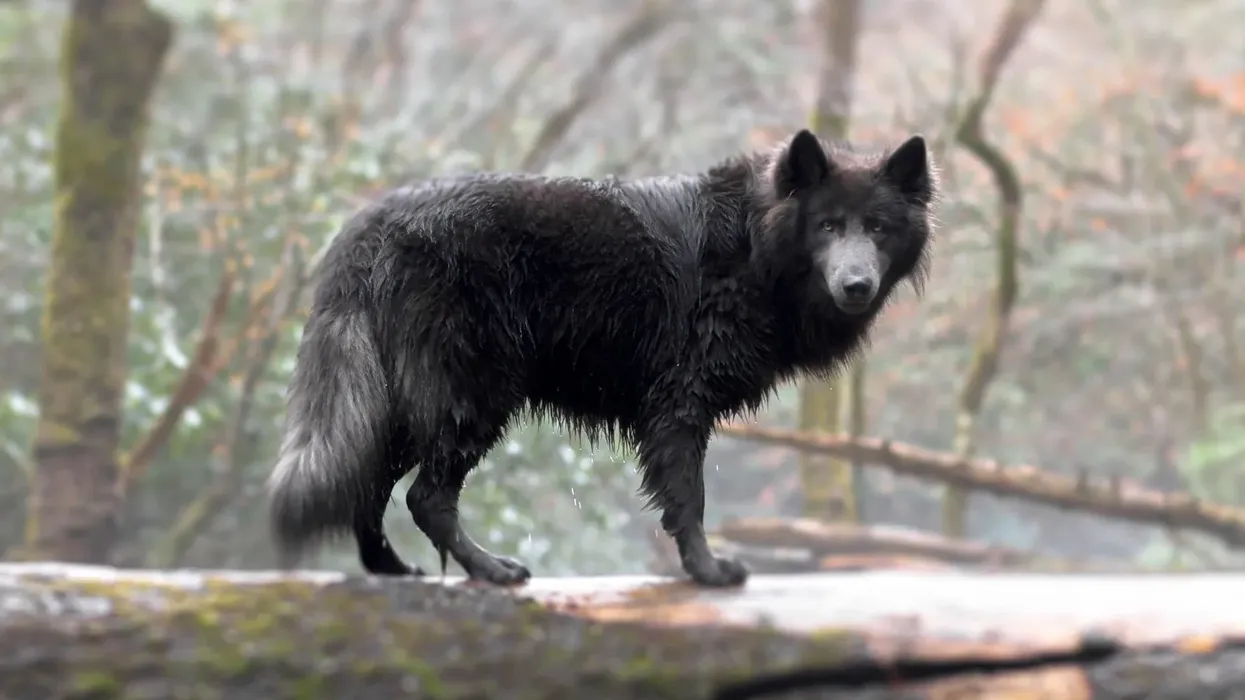Fun Blue Bay Shepherd Facts For Kids

The blue bay shepherds have been trending news and subject of enthusiasm among dog lovers throughout the world since their introduction.
The blue bay shepherd is a dog breed that is currently going through developmental stages.
The founder and developer of the breed, Vicki Spencer, has been working for the last 20 years in this line to get the perfect results, that is, a dog with the appearance of a wolf and the temperament of a German shepherd.
In order to derive the blue coat color of the blue bay shepherds, the lady searched through the lineage of European German shepherds with the rare blue coat.
After what one might call an arduous search, she was able to find the perfect one.
Palm bay in Florida has been the only breeding spot where wolf dogs and German shepherd dogs were chosen as the primary parent breeding dogs to get the desired results.
Although the breeding program enclosed within the boundaries of the Southern Breeze Ranch is in its development phase and very little information is available about the dogs, the breed has kept the entire world abuzz with excitement.
If you loved these amusing facts about this exclusive breed of the blue bay shepherd, then also read through some engaging facts about other shepherd dog breeds such as the Pyrenean shepherd and central Asian shepherd dog.
Blue Bay Shepherd Interesting Facts
What type of animal is a blue bay shepherd?
A blue bay shepherd is a dog breed.
What class of animal does a blue bay shepherd belong to?
The blue bay shepherd belongs to the class Mammalia.
How many blue bay shepherds are there in the world?
Since the breed has been introduced recently, these dogs are very rare as they are developed by Spencer alone. A handful of owners have the blue bay shepherd as pets. The exact details of their current numbers cannot be ascertained due to a lack of data.
Where does a blue bay shepherd live?
Blue bay shepherds are reared solely in the Southern Breeze Ranch owned by Spencer. However, their location is not limited to Palm Bay, Florida as anyone from around the world has access to a direct adoption from the owner herself. However, they are not found in Antarctica.
What is a blue bay shepherd's habitat?
The few blue bay shepherds that are currently in existence live with their proud owners. They are not found in rescues or shelters as their sole breeder is the only authentic seller of the breed in the global market. These dogs are found in cozy and comfortable homes, ideally with large spaces that would aid free movements.
Who do blue bay shepherds live with?
The blue bay shepherds are companions to human beings. It is not known whether they can survive in packs or the wilderness. The few that have been reared have found safe havens with their masters and their family members.
How long does a blue bay shepherd live?
Any conclusive statement about the longevity of these dogs cannot be made in the present context as more research and studies are required in this field.
How do they reproduce?
The reproduction process of these dogs is similar to that of any other breed. The breeding process can be initiated after the attainment of puberty. The females get their heat cycles at around six to eight months during which they become approachable and receptive to the males.
The breeding must be conducted under the supervision and guidance of professional breeders to ensure a healthy litter. The ideal breeding time is when the dogs are about two years of age.
After the dogs copulate, the females serve a gestation period of 60-63 days after conception. A healthy mother gives birth to healthy puppies. The litter size of the blue bay shepherds has not yet been disclosed to the world.
What is their conservation status?
The International Union for Conservation of Nature (IUCN) Red List has Not Listed the breed of the blue bay shepherd. This is perhaps the conservation of the dog breed is currently not a serious matter of concern as the world is yet to discover the breed for all its exuberance.
It can be mentioned that they are currently very few in number but expected to increase in the future with success in the breeding projects.
Blue Bay Shepherd Fun Facts
What do blue bay shepherds look like?

The gene pool from where this special breed has been developed comprises versatile dog breeds. Since these dogs have wolf blood they possess a genetically similar appearance as that of the wolf dogs.
With their large size, long fur coat, big light brown or blue eyes, long and fluffy tail, and erect ears, they make a royal appearance. The blue or slate gray color of their coat gives them a dignified look. The dog is sturdy and muscular in build with a strong muzzle and powerful jawline.
How cute are they?
When we say that beauty lies in the eyes of the beholder, we look for things that bear the potential to capture and blow our minds completely and this is where the extraordinary blue bay shepherd comes in. A blue bay shepherd puppy is a delightful sight to behold!
Blue bay shepherds have a majestic and enticing appearance. The unique blue or slate gray color of its coat make them all the more appealing.
They are large and fluffy with a lovable and affectionate nature. What more do we need from a furry cuddle companion?
How do they communicate?
Like any other dog, the blue bays primarily use vocalizations along with body language and gestures to express their minds. To express elation they might lick your face or even wag the tail excitedly.
Vocalizations include howling, growling, barking, snarling, whimpering, and whining. Barking itself can be categorized into several types.
A dog can bark when it senses something amiss, it can also bark to scare away some crows, or even to admonish people for not giving adequate attention. Usually, a dog whimpers and whines either when it is scared or in tremendous pain.
How big is a blue bay shepherd?
Blue bay shepherds have a huge structure with a height of approximately 30 in (76 cm). They are unquestionably larger than the labradors or beagles but they are smaller than great Danes.
How fast can a blue bay shepherd run?
The sprinting speed of the blue bay shepherds is yet to be recorded. Since the breed has just been introduced, speculation in several aspects is necessary. Nevertheless, these dogs are highly energetic and agile as they are descendants of highly active dogs, especially the German shepherds who excel in different dog sports.
How much does a blue bay shepherd weigh?
On average the weight of these large and bulky dogs ranges from 70-105 lb (32-47.6 kg). The male members of the breed are heavier with an average weight of about 80-105 lb (36-48 kg) while the females are comparatively lighter with their weight ranging from 70-85 lb (32-39 kg).
What are the male and female names of the species?
The male and female of the breed do not have distinct designations. They are called by their common names, that is, a dog and bitch respectively.
What would you call a baby blue bay shepherd?
A baby blue bay shepherd is referred to as a puppy. Many a time it is also called a pup with affection.
What do they eat?
The blue bay shepherds are large breed dogs. They come with a huge appetite and therefore, must be provided with wholesome and filling meals.
They are omnivorous in nature which implies that they can be offered a combination diet enriched with the benefits and goodness of vegetables, raw meat, fish, soft bones, fruits, nuts, and essential animal fats. These dogs need high amounts of proteins, vitamins, minerals, omegas, fats, and carbohydrates to boost their strength and energy levels.
The puppies are usually fed four to five times in small portions while the adults are offered two to three full meals per day. Nevertheless, the best-customized diet according to the requirements of the dog can be recommended by the vet.
Are they slobbery?
Several personality aspects of the blue bays need to be explored with time as they are newcomers and minuscule information is publicized. There is no data regarding their drooling tendencies.
Would they make a good pet?
Although much information about the temperament of the blue bays is not available, they are known to be excellent family dogs. They generally possess a gentle and soft temperament.
They are friendly with children and can also gel up with small animals with proper social training. Only the owner of blue bays would know how benign, obedient, and lovable they are.
Did you know...
The first litter of blue bays was born in the year 2011. The name 'blue bay' that defines the breed is ascribed to their blue color and their original location in Palm Bay.
None of the kennel clubs have provided the breed any recognition. The breed would need to stand the test of time and meet the requirements of these kennel clubs to gain their distinct identity and recognition.
Spencer, the sole breeder, has a positive outlook in this regard as she believes that these dogs would bring with them a plethora of benefits.
Since the blue bays are hybrid, they also come with certain health issues common to the parent breeds. Conditions like hip dysplasia, bloating, joint disorders, and depression are prevalent.
Additionally, they have daily exercise, training, grooming, and dietary requirements. Grooming involves cleaning and check-up of the ears and eyes, regular brushing, and a bath at least twice a month.
Brushing is important to keep the fur coat tangle-free and free from matting. Exercise requirements include at least half an hour of daily walks or runs or even just a simple game of fetch.
These large dog breeds are quite pocket-pinching. The allover costs of maintaining these dogs are on the expensive side. The cost of adopting a blue bay shepherd puppy is around $3,000 to $3,500. Only the Southern Breeze kennels in Florida run by Spencer herself offer this limited breed for adoption.
What is the rarest color of a German shepherd?
The blue color of the coat is extremely rare. The dogs inherited this unique color from the difficult-to-find European German shepherd with a blue coat that was imported from Europe. The European German shepherd that was used for breeding was brought to France. These blue-tinted German shepherds are very rare and cannot be found very easily.
Do blue bay shepherds have wolf DNA in them?
These dogs have wolf ancestors and are descendants of the German shepherds. According to the breeder, Vicki Spencer, she has been trying ardently to limit the wolf content in this new breed to only 6%.
Nevertheless, the wolf DNA in the first line breeding still ranges from 6-42%. However, the success of the breeding program largely depends on the characteristics inherited by the next few generations.
Here at Kidadl, we have carefully created lots of interesting family-friendly animal facts for everyone to discover! Learn more about some other mammals from our tree kangaroo facts and kuvasz facts pages.
You can even occupy yourself at home by coloring in one of our free printable blue bay shepherd coloring pages.
Thank you to Kidadler Hailie Whatley for providing the image of their pet Blue Bay Shephard in this article.
We Want Your Photos!
More for You
See All
Bachelor of Arts specializing in Journalism and Mass Communication, Postgraduate Diploma in Sports Management

Moumita DuttaBachelor of Arts specializing in Journalism and Mass Communication, Postgraduate Diploma in Sports Management
A content writer and editor with a passion for sports, Moumita has honed her skills in producing compelling match reports and stories about sporting heroes. She holds a degree in Journalism and Mass Communication from the Indian Institute of Social Welfare and Business Management, Calcutta University, alongside a postgraduate diploma in Sports Management.
Bachelor of Arts specializing in Economics

Gowri RaoBachelor of Arts specializing in Economics
With a bachelor's degree in Economics from Krea University, Gowri is a highly skilled data analyst and an expert in regression and causation modeling. Her interests in economic trends, finance, and investment research complement her professional expertise. In addition to her professional pursuits, Gowri enjoys swimming, running, and playing the drums, and she is also a talented tutor.
Disclaimer
1) Kidadl is independent and to make our service free to you the reader we are supported by advertising. We hope you love our recommendations for products and services! What we suggest is selected independently by the Kidadl team. If you purchase using the Buy Now button we may earn a small commission. This does not influence our choices. Prices are correct and items are available at the time the article was published but we cannot guarantee that on the time of reading. Please note that Kidadl is a participant in the Amazon Services LLC Associates Program, an affiliate advertising program designed to provide a means for sites to earn advertising fees by advertising and linking to Amazon. We also link to other websites, but are not responsible for their content.
2) At Kidadl, we strive to recommend the very best activities and events. We will always aim to give you accurate information at the date of publication - however, information does change, so it’s important you do your own research, double-check and make the decision that is right for your family. We recognise that not all activities and ideas are appropriate for all children and families or in all circumstances. Our recommended activities are based on age but these are a guide. We recommend that these ideas are used as inspiration, that ideas are undertaken with appropriate adult supervision, and that each adult uses their own discretion and knowledge of their children to consider the safety and suitability. Kidadl cannot accept liability for the execution of these ideas, and parental supervision is advised at all times, as safety is paramount. Anyone using the information provided by Kidadl does so at their own risk and we can not accept liability if things go wrong.
3) Because we are an educational resource, we have quotes and facts about a range of historical and modern figures. We do not endorse the actions of or rhetoric of all the people included in these collections, but we think they are important for growing minds to learn about under the guidance of parents or guardians.







